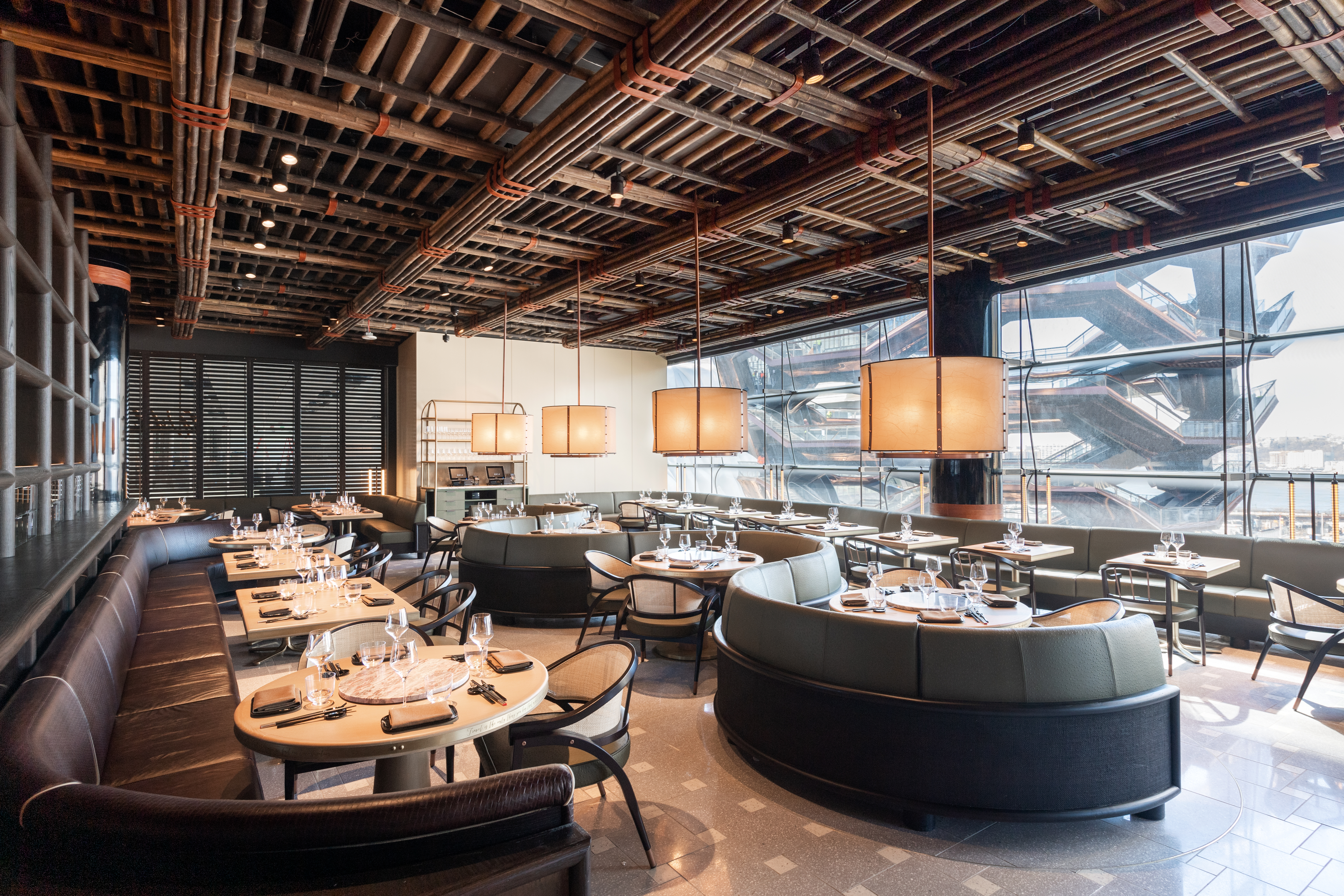Hudson Yards is the largest mixed use private real estate venture in American history. Having officially opened for business earlier this year, the development along Manhattan’s West Side has produced fundamental changes to the iconic skyline and the very fabric of the city.
Hudson Yards’ first phase of construction, now completed, includes eight new buildings that provide millions of square feet of office and residential space augmented by high-end shopping, dining and other amenities. The development features a cultural facility (The Shed) and the 16-story Vessel, an art installation of connected staircases designed by Thomas Heatherwick in an open-air public plaza. Hudson Yards’ first phase also includes a seven-story mall, the Shops and Restaurants at Hudson Yards, which includes 100 shops and 20 restaurants.
The high-profile Hudson Yards project attracted elite UK hospitality group Rhubarb to plant its first overseas outpost with Wild Ink, an Asian-inspired restaurant with an international approach that’s located in the Shops and Restaurants at Hudson Yards.

Design is naturally of the utmost importance within such a landmark. The cornerstone of Wild Ink’s motif is a striking bamboo ceiling oriented in a grid-like fashion that imparts a subtly rustic meets contemporary Asian ambiance. While visually arresting, the interior concept was sonically problematic, challenging the restaurant group’s intent to provide an enveloping, high-fidelity sonic environment for diners. The inherent complexities were in part what led Rhubarb to the restaurant audio design expertise of Essential Communications, an audiovisual integrator based in East Hanover, NJ.
Restaurant construction was already underway when Essential Communications was brought on board. The project was on an aggressive timeline, and acoustical considerations were not initially accommodated for. The environment needed to sound superior, yet the audio system had to be invisible—a challenge that was further complicated by duct work and air handlers that weren’t immediately apparent.
The space between the decorative bamboo grid and the actual ceiling was limited, so flexibility was key in selecting loudspeakers. Essential Communications eventually landed on pendant-style speakers, as they could be mounted from a single point. QSC’s AD-P6T pendant-mount loudspeakers were paired with 12-inch subwoofers, which required more solid mounting space, but due to their omnidirectional nature, placement wasn’t as critical. The pendants, which act like spotlights, are placed over large banquette seating areas, while the QSC AD-S112sw subwoofers could be spread around with less concern for the specificity of their coverage.
The Essential Communications team designed the entire audio system on the QSC Q-SYS Ecosystem for its integrated control and audio processing, along with the simple nature of the user interface and touchscreens. “We wanted it to be simple because the most important aspect of the UI is the user,” explained David Schwartz, president, Essential Communications. “It can’t be like operating the Star Trek Enterprise.”
Noting how important aesthetics are in high-end restaurants, Schwartz said QSC’s UI and touchscreens lend themselves to a clean, attractive look. The interface Essential Communications designed is basically a restaurant logo with controls placed in a mixing console style with sliders. The integrated nature of the Q-SYS platform means there are no coding issues trying to get the DSP to talk to control. “The convenience of programming and making it look good for the customer is what drives me to those products,” Schwartz said.
The client requested that several DJ input jacks be installed throughout the dining room, allowing them to bring in guest DJs or other sources. Doing so would also provide more flexibility to sell out the restaurant for events. The integration team chose Attero Tech AES67 networked audio wall plates for the range of inputs they offer, along with the ability to run digital signals over Cat-5 cable back to the QSC Core 110f processor. “The cool thing about the entire QSC world with the DSP and Attero Tech wall plates is that they all network together. It’s all being connected through the same switch,” Schwartz said.
[Nightclubs and Bars Merge Technology and Design]
Music playing in four individual restrooms emanates from SoundTube flush-mount ceiling speakers. Overall, the system comprises just four zones covering the bar, two dining room zones, and the bathrooms. This decision was driven by the client based on experiences in their other restaurants.
Essential Communications was also tapped to provide the network and security systems for the restaurant and the back-end operations office at Wild Ink. Closed-circuit cameras were placed throughout the space. The Essential Communications team partnered with Adam Weintraub and Fusion Electronic Systems on the security system, and Schwartz praised their expertise as being integral to the design and implementation of the CCTV and access control. Weintraub also led the daily job site operations, including installation and site supervision.
Wi-Fi was an important feature for the client. In addition to a public guest network, a wireless POS enables servers to place orders tableside with a mobile device. Wild Ink’s main IT rack is located in an operations office on a separate floor from the restaurant, where the AV and security racks are housed. The distance was too far to run category cable, so the team laid 1,000 feet of fiber, which also ensured the speed required. The move is indicative of a larger trend, with fiber really coming into its own in light of internet speeds and copper limitations, Schwartz noted.
Beyond the design of this project, the construction challenges associated with Hudson Yards were persistent. Safety standards were stringent, with all the latest OSHA certifications, random drug and alcohol tests conducted, and background checks required for every individual on site. The team needed contingency plans in place and extra people trained and certified in the event someone was out sick. Even the deliveries were strictly scheduled, which added time and money daily. Overall, an incredible amount of coordination was required to adhere to Hudson Yards’ standards. It was no easy feat, yet, Schwartz noted, “Our team responded flawlessly.”
While the challenges were many, the Essential Communications team effectively anticipated the needs based on their experience with similar implementations. At the core of this success was a mutual trust and respect with the client. “We were truly a consultative resource,” Schwartz said. “The client trusted our experience, and they benefitted from that.”
